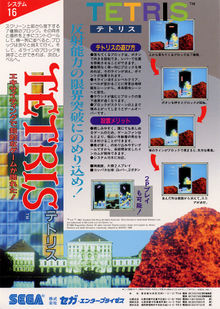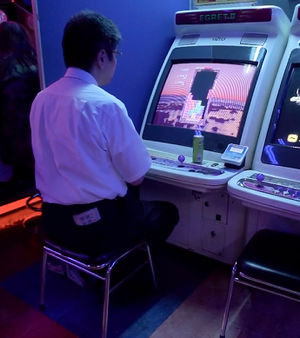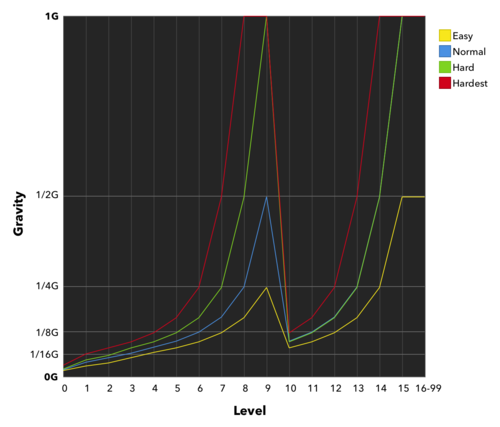Tetris (Sega): Difference between revisions
No edit summary |
|||
| Line 15: | Line 15: | ||
{{about2|the 1988 arcade version|the 1999-2000 arcade and Dreamcast version|Sega Tetris}} | {{about2|the 1988 arcade version|the 1999-2000 arcade and Dreamcast version|Sega Tetris}} | ||
'''''Tetris''''' is an arcade game published by [[Sega]] in [[1988 in Tetris|1988]]. It took Japanese arcades by storm, and is one of the most commonly known versions of the game. Due to its popularity, it became the base of rules for many other Japanese games created later on, both licensed and unlicensed. Such games include the [[TGM series]], [[Tetris Plus]] series, [[Tetris S]] and [[ТЕТРИС SEMIPRO-68k|Shimizu Tetris]]. It was one of the first games to | '''''Tetris''''' is an arcade game published by [[Sega]] in [[1988 in Tetris|1988]]. It took Japanese arcades by storm, and is one of the most commonly known versions of the game. Due to its popularity, it became the base of rules for many other Japanese games created later on, both licensed and unlicensed. Such games include the [[TGM series|''TGM'' series]], ''[[Tetris Plus]]'' series, ''[[Tetris S]]'' and ''[[ТЕТРИС SEMIPRO-68k|Shimizu Tetris]]''. It was one of the first games to have [[lock delay]], greatly improving maneuverability at high speeds. | ||
==Gameplay== | ==Gameplay== | ||
[[Image:Japanese_Man_Playing_Tetris.jpg|300px|thumb|right|Japanese man playing ''Tetris'' (Sega)]] | [[Image:Japanese_Man_Playing_Tetris.jpg|300px|thumb|right|Japanese man playing ''Tetris'' (Sega)]] | ||
Sega's version of ''Tetris'' is an endless game with the only goal being to score points. As the player progresses, the levels increase thereby changing the game speed. Highly skilled players can play indefinitely, even when the score counter stops at 999,999 points, though players usually stop once this is achieved. | |||
Being an early game, released just one year after [[Elorg]] licensed ''Tetris'' to publishers, [[tetromino]]es can only be rotated counterclockwise. Unlike these games however, this version has 3 buttons which can be tapped quickly in a piano-like motion, equivalent to a clockwise rotation. | Being an early game, released just one year after [[Elorg]] licensed ''Tetris'' to publishers, [[tetromino]]es can only be rotated counterclockwise. Unlike these games however, this version has 3 buttons which can be tapped quickly in a piano-like motion, equivalent to a clockwise rotation. | ||
It did not implement [[wall kick]]s or [[hard drop]]. However, many of the mechanics that exist in later games were first | It did not implement [[wall kick]]s or [[hard drop]]. However, many of the mechanics that exist in later games were first seen in this version, such as 1G [[DAS]] movement, lock delay, [[ARE]], and rotation/movement processed before gravity—allowing for [[TGM legend#Synchro|synchro]] moves to be performed at 1G fall speed. | ||
A game design element not commonly seen in recent games is the existence of a [[ceiling]]. The [[playfield]] height is 20 rows, and any rotation that would exceed that height will fail. At high gravity speeds, players must time their piece rotations so the piece is not touching the ceiling, and also not stuck in the stack. | A game design element not commonly seen in recent games is the existence of a [[ceiling]]. The [[playfield]] height is 20 rows, and any rotation that would exceed that height will fail. At high gravity speeds, players must time their piece rotations so the piece is not touching the ceiling, and also not stuck in the stack. | ||
| Line 34: | Line 36: | ||
=== Speed Levels === | === Speed Levels === | ||
[[Image:Sega_speed_graph.png|thumb|none|500px|Graph of gravity timings per level]] | [[Image:Sega_speed_graph.png|thumb|none|500px|Graph of gravity timings per level]] | ||
The game difficulty can be configured through the DIP switch on the arcade board. | |||
{| class="wikitable mw-collapsible mw-collapsed" | {| class="wikitable mw-collapsible mw-collapsed" | ||
|+ style="white-space: nowrap;" | Fall speed table; frames per cell | |+ style="white-space: nowrap;" | Fall speed table; frames per cell | ||
| Line 72: | Line 75: | ||
=== Level advancement requirements === | === Level advancement requirements === | ||
There are | There are two ways to increase the level: | ||
* Clear 4 lines in any combination of [[line clear]]s. | * Clear 4 lines in any combination of [[line clear]]s. | ||
* Place a | * Place a tetromino after the "level timer" reaches a certain value. (Level will not increase if a line clear happens. <abbr title="Does this mean the timer resets or simply wait until the next non line clearing piece is placed?"><sup>[Clarification needed]</sup></abbr>) | ||
The level timer increases every frame, except when reset after line clearing and before level-up is shown. | The level timer increases every frame, except when reset after line clearing and before level-up is shown. | ||
| Line 118: | Line 121: | ||
==Power-on Pattern== | ==Power-on Pattern== | ||
One characteristic of this version of Tetris was the existence of a | {{main|Power-on pattern}} | ||
One characteristic of this version of ''Tetris'' was the existence of a Power-on pattern. This referred to the game's behavior that the string of pieces it dealt in the very first game after starting up the system was always the same. This was most probably caused by the state of the randomization seed in the system. After its discovery, players began constructing gameplay plans around the power-on pattern in order to max out the score in the least lines possible. ''[[Sega Tetris]]'' (1999, Arcade, Dreamcast) pays tribute to the power-on pattern, by dealing the sequence in the final level of the single-player game. ''[[Tetris S]]'' also contains the pattern. | |||
For MAME players, unless you are playing the bootleg, you must delete your NVRAM before playing to get the power-on pattern. The B-system version has a different power-on pattern, and does not require you to delete your NVRAM. It even restores the pattern upon reset, which not even the bootleg will do. The System E version does not have a power-on pattern. <!-- check H-system --> | |||
== TAS == | == TAS == | ||
Revision as of 13:00, 31 December 2018
| Tetris | |
|---|---|
 | |
| Developer(s) | Sega |
| Publisher(s) | Sega |
| Platform(s) | Sega System 16B Sega System 16A Sega System E Taito H System Taito B System |
| Release | December 20, 1988 |
| Gameplay info | |
| Next pieces | 1 |
| Playfield size | 10 × 20 |
| Hold piece | No |
| Hard drop | No |
| Rotation system | Sega Rotation (no wall kicks) |
- This article is about the 1988 arcade version. For the 1999-2000 arcade and Dreamcast version, see Sega Tetris.
Tetris is an arcade game published by Sega in 1988. It took Japanese arcades by storm, and is one of the most commonly known versions of the game. Due to its popularity, it became the base of rules for many other Japanese games created later on, both licensed and unlicensed. Such games include the TGM series, Tetris Plus series, Tetris S and Shimizu Tetris. It was one of the first games to have lock delay, greatly improving maneuverability at high speeds.
Gameplay

Sega's version of Tetris is an endless game with the only goal being to score points. As the player progresses, the levels increase thereby changing the game speed. Highly skilled players can play indefinitely, even when the score counter stops at 999,999 points, though players usually stop once this is achieved.
Being an early game, released just one year after Elorg licensed Tetris to publishers, tetrominoes can only be rotated counterclockwise. Unlike these games however, this version has 3 buttons which can be tapped quickly in a piano-like motion, equivalent to a clockwise rotation.
It did not implement wall kicks or hard drop. However, many of the mechanics that exist in later games were first seen in this version, such as 1G DAS movement, lock delay, ARE, and rotation/movement processed before gravity—allowing for synchro moves to be performed at 1G fall speed.
A game design element not commonly seen in recent games is the existence of a ceiling. The playfield height is 20 rows, and any rotation that would exceed that height will fail. At high gravity speeds, players must time their piece rotations so the piece is not touching the ceiling, and also not stuck in the stack.
Details
- Soft drop: 1G
- Lock delay: 30 frames
- ARE: 30 frames
- Line clear delay: 42 frames
- DAS: 20 frames
Speed Levels

The game difficulty can be configured through the DIP switch on the arcade board.
| Level | Easy | Normal | Hard | Hardest |
|---|---|---|---|---|
| 0 | 48 | 48 | 40 | 30 |
| 1 | 32 | 24 | 20 | 15 |
| 2 | 24 | 18 | 16 | 12 |
| 3 | 18 | 15 | 12 | 10 |
| 4 | 14 | 12 | 10 | 8 |
| 5 | 12 | 10 | 8 | 6 |
| 6 | 10 | 8 | 6 | 4 |
| 7 | 8 | 6 | 4 | 2 |
| 8 | 6 | 4 | 2 | 1 |
| 9 | 4 | 2 | 1 | 1 |
| 10 | 12 | 10 | 10 | 8 |
| 11 | 10 | 8 | 8 | 6 |
| 12 | 8 | 6 | 6 | 4 |
| 13 | 6 | 4 | 4 | 2 |
| 14 | 4 | 2 | 2 | 1 |
| 15 | 2 | 1 | 1 | 1 |
Level advancement requirements
There are two ways to increase the level:
- Clear 4 lines in any combination of line clears.
- Place a tetromino after the "level timer" reaches a certain value. (Level will not increase if a line clear happens. [Clarification needed])
The level timer increases every frame, except when reset after line clearing and before level-up is shown.
| Level | 0 | 1 | 2 | 3 | 4 | 5 | 6 | 7 | 8 | 9 | 10 | 11 | 12 | 13 | 14 | 15 | 16-99 |
|---|---|---|---|---|---|---|---|---|---|---|---|---|---|---|---|---|---|
| Required time (frames) | 3480 | 2320 | 2320 | 2320 | 2320 | 2320 | 2320 | 2320 | 2320 | 3480 | 3480 | 1740 | 1740 | 1740 | 1740 | 3480 | 3480 |
| Required time (Seconds) | 58 | 38.67 | 38.67 | 38.67 | 38.67 | 38.67 | 38.67 | 38.67 | 38.67 | 58 | 58 | 29 | 29 | 29 | 29 | 58 | 58 |
Level 15 value is used for levels 16 to 99.
Scoring
| Level | Points for 1 line |
Points for 2 lines |
Points for 3 lines |
Points for 4 lines |
Points for soft dropping pieces |
|---|---|---|---|---|---|
| 0-1 | 100 | 400 | 900 | 2000 | 1 per line |
| 2-3 | 200 | 800 | 1800 | 4000 | 2 per line |
| 4-5 | 300 | 1200 | 2700 | 6000 | 3 per line |
| 6-7 | 400 | 1600 | 3600 | 8000 | 4 per line |
| 8+ | 500 | 2000 | 4500 | 10000 | 5 per line |
If a line clear is also a Perfect Clear, a 10x multiplier is applied to the awarded points.
Notes
- Current piece fall speed is located at
C7000Ahin the RAM. - Current level timer is located at
C72336h(word) in RAM in System 16A version;FFE336hin System 16B version. This table is located at3D28in the 68k portion of an unshuffled ROM for System 16B version.
Power-on Pattern
- Main article: Power-on pattern
One characteristic of this version of Tetris was the existence of a Power-on pattern. This referred to the game's behavior that the string of pieces it dealt in the very first game after starting up the system was always the same. This was most probably caused by the state of the randomization seed in the system. After its discovery, players began constructing gameplay plans around the power-on pattern in order to max out the score in the least lines possible. Sega Tetris (1999, Arcade, Dreamcast) pays tribute to the power-on pattern, by dealing the sequence in the final level of the single-player game. Tetris S also contains the pattern.
For MAME players, unless you are playing the bootleg, you must delete your NVRAM before playing to get the power-on pattern. The B-system version has a different power-on pattern, and does not require you to delete your NVRAM. It even restores the pattern upon reset, which not even the bootleg will do. The System E version does not have a power-on pattern.
TAS
A TAS for Sega Tetris abuses lock delay and gravity resets to keep pieces active until the level timer expires to level up as much as possible with the fewest lines cleared. At a higher level the lines cleared will award more points thus needing fewer total lines to achieve a maxout.
(TAS) Sega Tetris maxout in 98 lines
Development of Taito H System version
See also
- Sega Ages 2500 Series Vol.28 Tetris Collection - This collection featured a port of Tetris (Sega) as one of its playable titles with a few extra gameplay options.
- Tetris (Sega) Techniques
| |||||||||||
